Posts Categorized / Main Blog
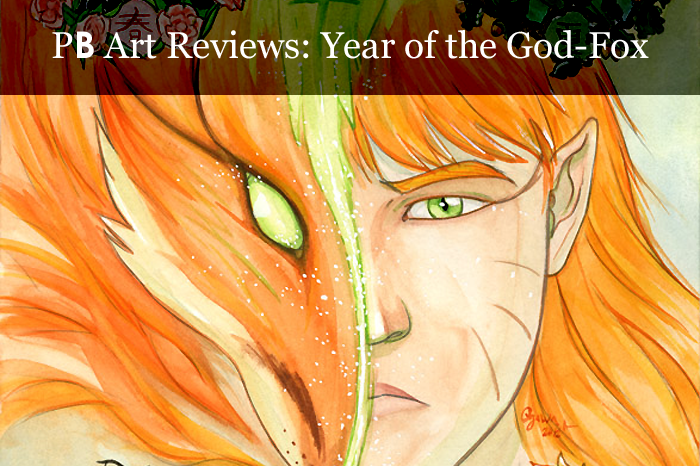
I’m a sucker for stories where nonhuman characters struggle to decipher and navigate a human-centric world. Whether they strive to be like us or undermine us, the perspective they offer on our own nature through their difference can be refreshing and thought-provoking, and their difficulties managing our social and cultural constructs echo a frustration with the norms of our world that many of us feel from time to time. Goldeen Ogawa’s Year of the God-Fox effectively uses the perspective of a nonhuman character to tell a fun yet thoughtful tale about the complexities of the human experience and the value of life. This review covers Books One and Two of the story, as the rest has not yet been released.
The tale begins as Saimaru, a kitsuné or “God-Fox,” is sentenced to live for a year as a human as punishment for attacking a village. Saimaru considers his kind far superior to humans, and his utter disdain for “lower” life makes the transition to the human world awkward and humiliating. Still, it’s not long before Saimaru meets other characters who both help him and drag him half-grumbling along into adventures. He works picking fruit, eats raw fish, barely tolerates having his hair done, and questions everything he knows.
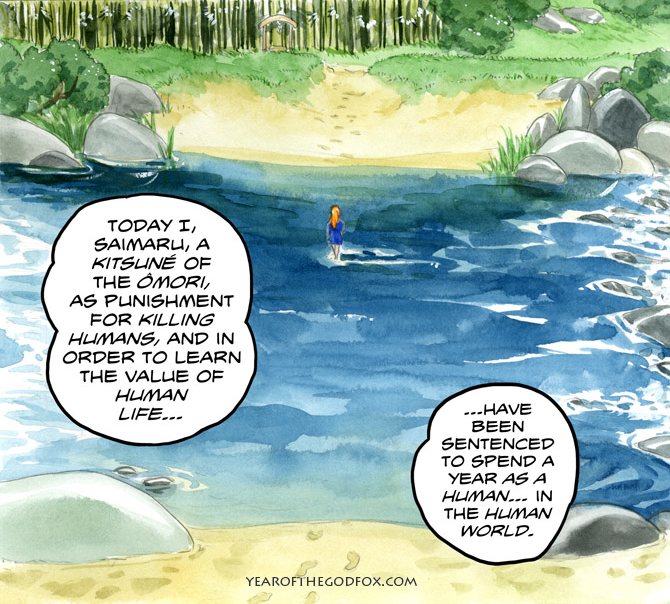
Author-artist Goldeen Ogawa has a knack for imbuing her characters and worlds with life and personality through a variety of quirks, flaws, and nuances rather than falling back on common stereotypes. Even the cruelest of her characters have dimension and believable motives. Ogawa explains on the comic’s About page that Year of the God-Fox is her answer to stories with supernatural characters in which humans are “portrayed as boring and stupid.” She aims to show “one of these proud non-humans” confronting “the intricacies and quiet strengths of humanity,” and so far she has done just that. Just before Saimaru is turned human, we get a first of many glances of human nature in the villagers Saimaru attacks, and Saimaru’s behavior and beliefs throughout the story so far are repeatedly challenged by humans who prove to be something more than he expected.
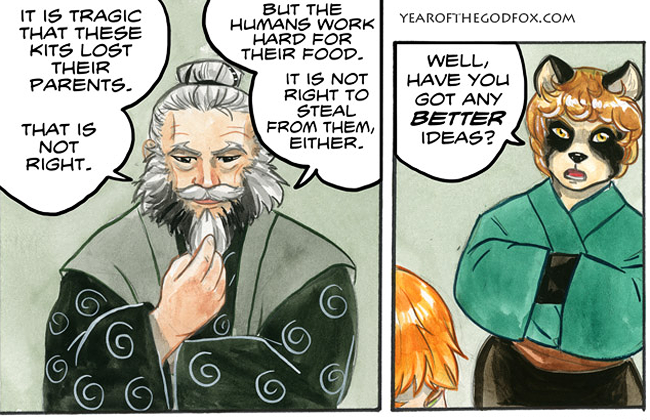
There is a the powerful contrast between Saimaru’s attitude toward other life-forms and the attitudes of others he meets throughout Year of the God-Fox. He compares humans to animals “not worthy of our respect” several times, and in one scene he suggests that a God-Fox killing humans is “different” from humans killing each other, “rather like a human would think less of killing a dog.” Saimaru is also upset by Pomoko, a tanuki, cooking the fish he eats because she is “an inferior species.” But the other creatures Saimaru meets don’t think as he does. They’re not perfect, but they are often good-hearted. The people of the Village Protected By Foxes honor their agreement seemingly for generations, and Meibei’s cousin values the truth highly enough to put himself at risk so she may escape danger. Meibei’s simple response to Saimaru’s comment about killing a dog speaks volumes about how differently they perceive the value of life.
The art in Year of the God-Fox varies from rich natural scenes to simpler backgrounds that keep the focus on a single person or event. The characters are varied and highly expressive. Manga influences are present, yet Ogawa’s style stands on its own. I particularly noticed and enjoyed the way art in some panels seems to echo others in a thematic manner the same way the dialogue does. When Meibei recounts her mother’s death, Ogawa depicts her and her dragon-owl companion on opposite ends of a wide panel with emptiness between, implying a sense of loss. Another final goodbye later in the story is reminiscent of that scene, but this time, she has the closure of a last embrace and her new friends nearby to support her.
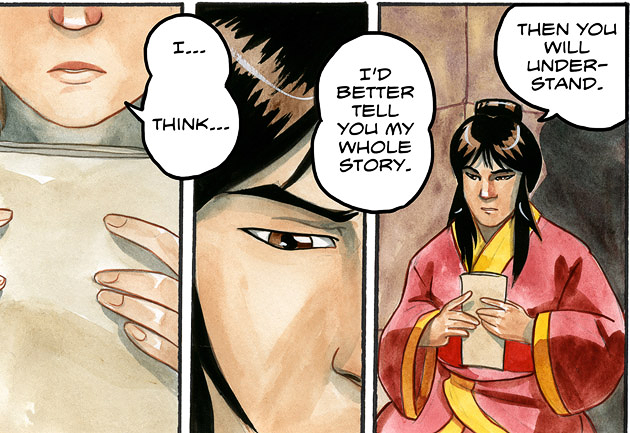
There’s a good deal more going on in Year of the God-Fox, but I don’t want to give it all away, and much is yet to be revealed. I’ve enjoyed Ogawa’s comics before and feel confident the entirety of Year of the God-Fox will be just as worthwhile a read. Visitors to the webcomic’s site will find the story organized into four books titled after the seasons, each containing several chapters; preview pages and bonus material are available for each chapter, and PDFs of the books are planned for later release. Books One (Summer) and Two (Autumn) are up on the site at the time of this review, but the entire comic is slated to be available by early summer 2014.
“Year of the God-Fox” can be read or previewed at YearoftheGodFox.com. More information about the author and her other works is available on her blog or at the Heliopause Productions site.
A while ago, I asked my tumblr followers what they wanted to see next as I continue to develop my toony bug style. Those requests are now in the works, and I thought there might be interest in how the bugs happen!
I approach the design for each species like character development on a broad scale. I want something that physically resembles each bug, can be customized to distinguish individual characters in a story, and has an appealing (often cute) factor that minimizes the “ew!” reaction some people have to insects.
The process can differ depending on how I imagine each species. For example, here’s a cockroach:
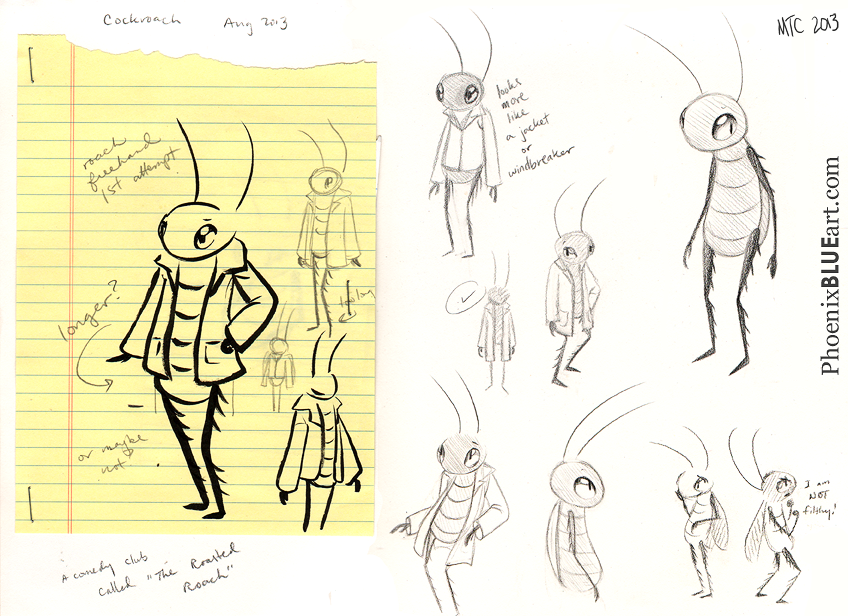
I’d already drawn cockroaches a few times and had a strong idea of how I wanted them to look, so I roughed out an idea in ink (on the yellow paper) and refined it through several pencil drafts. It didn’t take a lot of tries to get something I was happy with.
But sometimes I don’t have a solid idea of what I want a critter to look like in my bug style! I had a lot more trouble working on the grasshopper. The body wasn’t too hard to figure out, but I knew I wanted it to be facially distinct from other bugs so it could be easily picked out in bust images.
I referenced images of real grasshoppers. I drew a lot in ballpoint pen to get any and all ideas out there without worrying about fixing one sketch over and over. It was important to be able to compare what did and didn’t work and think about why. By the bottom of the page, I was hitting on it more than missing. Even the sketches that didn’t say “grasshopper” to me weren’t wastes, though – I got a solid idea of how I want an orchid mantis to look from one of the first attempts.
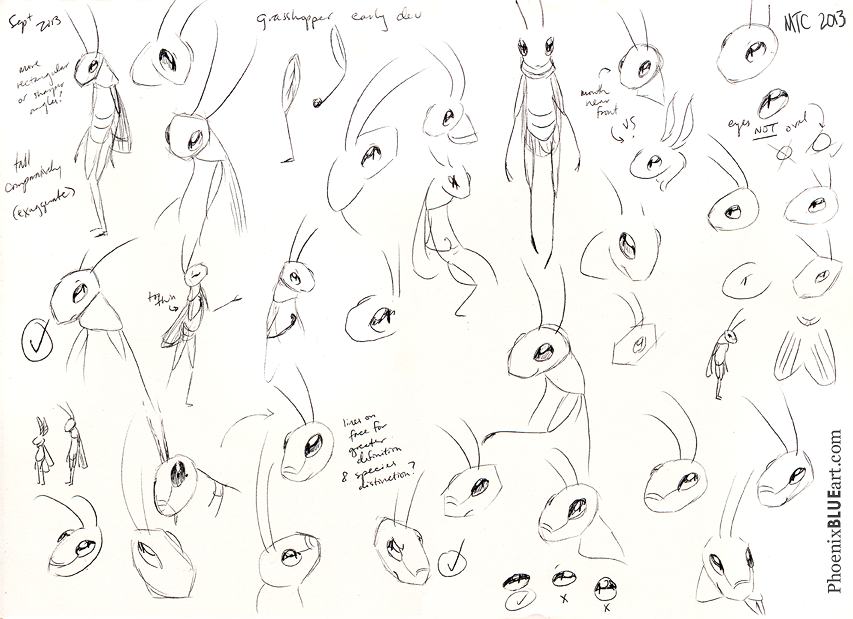
Using the head design I decided on, I drew a couple grasshoppers on the backs of my business cards without saying what they were. Someone on twitter said, “Oh, look, you did grasshoppers!” Bingo.
Another requested bug was damselflies. Though I hadn’t drawn them before, I got a strong impression of how they should look in my style by browsing photos of them. Their real eyes pretty much look how I’d draw them, and their head shape was fun to tackle.
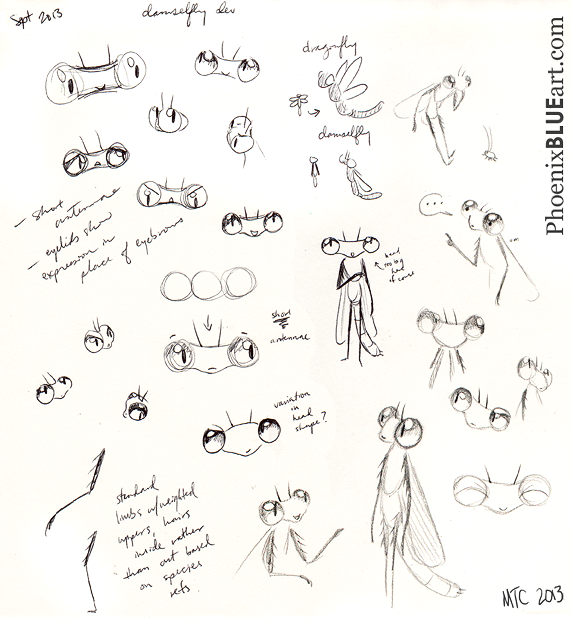
I’m going to really enjoy taking advantage of those big peepers for expressions.
(this entry has been cross-posted from tumblr with minor changes)
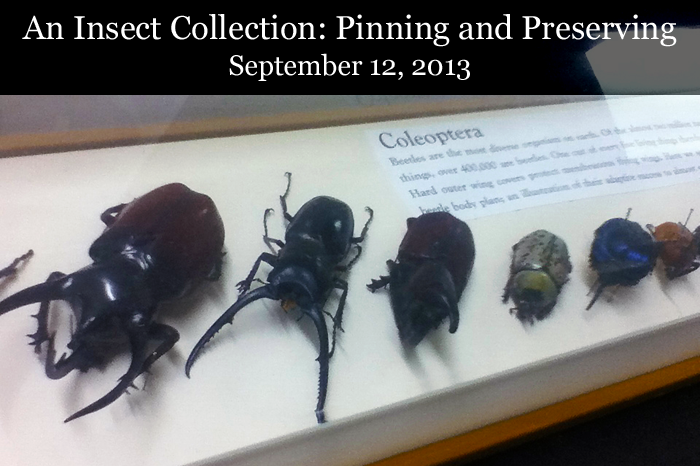
This week, I took an adult class at the Academy of Natural Sciences on insect pinning and preserving. Since I draw and paint bugs often, both realistically and as cartoons, I thought it’d be wise to learn how to collect specimens as references – sometimes photos don’t provide me the information I need for my work. The class proved to be a rewarding experience, as I got to see some of the Academy’s research collection, learn about how to catch, preserve, and pin insects, and pin four bugs of my own. I even met a couple of artists while I was at it.
After introducing themselves, Greg Cowper (Entomology Curatorial Assistant) and Karen Verderame (Live Invertebrate Specialist) opened the class with a discussion of collection methods used by entomologists – everything from aerial nets to pitfall and carrion traps. Some were active or passive, some used or didn’t use lights, but the goal of every technique was to collect intact insects for preservation and study. Greg and Karen used a Powerpoint of images to illustrate each method as it was used in the field and show results.
Next, we went back into the Academy’s collection, which is housed in a large, cooled room with compact rolling shelving units. Greg talked a little about the history of the collection and what has historically been done to help preserve it (today, the collection is frozen in parts on rotation to kill specimen-eating beetles). Then, he started taking out boxes to show us. I didn’t have my good camera on hand, but I wasn’t going to go without photos:


Left: Greg brings a box out of storage.
Right: Greg holds up a preserved Katydid with one wing extended.
We saw bees, beetles, grasshoppers, a katydid, and butterflies. Greg talked about how some of the Academy’s collection had been acquired from a repossessed storage unit and how the boxed specimens fit perfectly in the slots of a donut cart for freezing. Lots of questions were asked and answered!

A male birdwing butterfly – the largest butterfly species in the world.

Greg explains that the birdwing butterfly is sexually dimorphic – this female is even larger than the male.
Our group probably could’ve spent all night in the collections, but eventually, we returned to the classroom. Before resuming the Powerpoint, we all talked about why we were attending. There were at least two artists besides me in the room and plenty of hobbyists with memories of collecting bugs as kids. Greg and Karen then discussed where to get supplies for pinning and the proper methods for pinning different kinds of bugs. Each attendee was given three beetles to pin, and off we went! Some people chose to keep the insects’ legs tucked under, which is apparently preferable for scientific preservation; others, like myself, spread the legs slightly for a more lifelike or artistic appearance.

Two of the beetles I pinned.
Greg came around to check our work and help people as needed. Everyone did very well, especially for their first few tries! Cigar boxes were passed out to take our beetles home in, and then Greg gave each attendee a butterfly to pin while Karen circled the room with a live katydid walking up her arms. I was given a beautiful wooden cigar box but traded with another woman who said mine “spoke to her.”

My butterfly (Idea sp.), mid-pinning.
We spread and flattened the butterflies’ wings with glassine strips and pins. I had to use an extra piece of glassine to get my butterfly’s abdomen to stay straight and flat. While we weren’t able to take our butterflies home then and there – they’re drying at the Academy for later retrieval – we did take our beetles when the class ended. Before leaving, I talked to the other artists in the class and exchanged contact information. I’ll be interested to see whether what we learned shows up at all in either of their upcoming work!
Overall, the class was a fun and valuable learning experience, and I’d recommend it or one like it to anyone interested in insects. I got to see some of the oldest collection of bugs in this hemisphere, take notes from professionals on how to catch and preserve insects, and get guidance on exactly how to handle and pin delicate specimens. It wasn’t nearly as difficult as I expected, and being surrounded by other people as fascinated by bugs as me for a few hours was refreshing. I’d definitely like to do more activities like this in the future!





 Posted by Mary in
Posted by Mary in 









